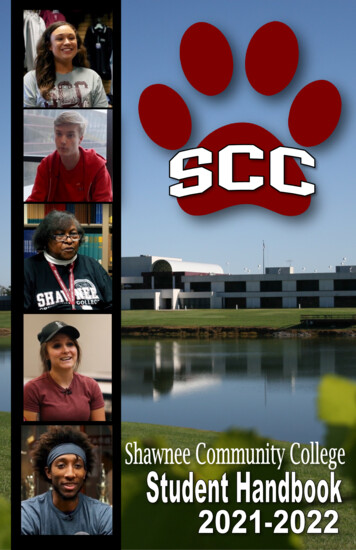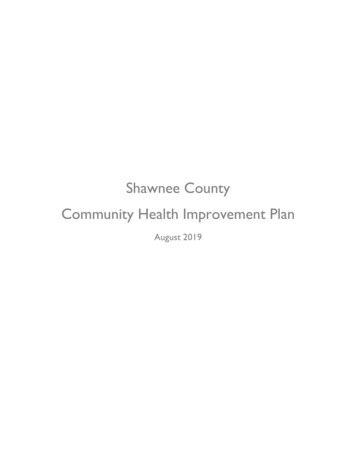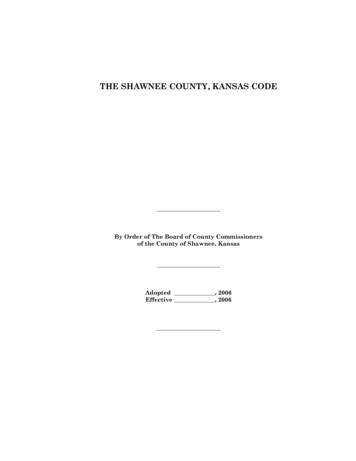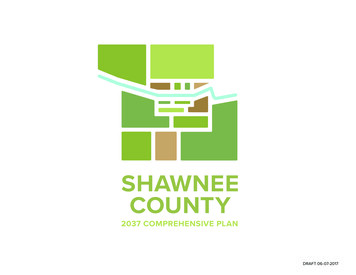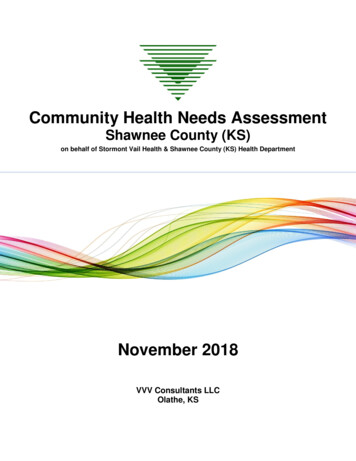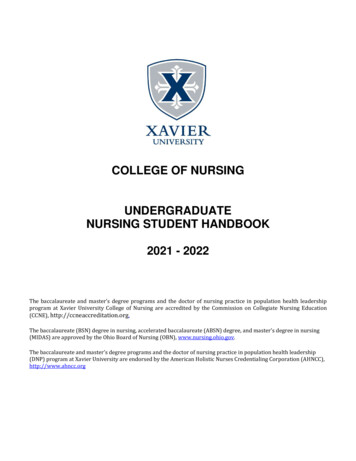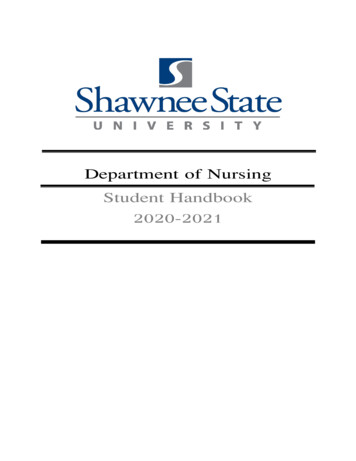
Transcription
Department of NursingStudent Handbook2020-2021
PREFACEThis Department of Nursing Student Handbook is designed to share information, procedures, andpolicies specific to students enrolled in the nursing programs at Shawnee State University. Theinformation presented here will be helpful as you negotiate your way through the nursingprograms. Our expectation is that you will use this handbook as your first point of reference whenyou have questions concerning your program of study or academic policies. Please retain thishandbook throughout your enrollment with the Department of Nursing.It is important that you check the electronic version available through the Department ofNursing web portal at f.You will receive emails when changes are made. The staff and faculty of the Department ofNursing are able to answer your questions, to assist you in planning your academic program,and to advise you as you make postgraduate plans. You can stop by the office of theDepartment of Nursing to schedule an individual appointment with your advisor or theChairperson.You are engaged in an exciting, challenging, and rewarding journey. While the primaryresponsibility for your success lies with you, many individuals stand ready to assist you inyour efforts. We wish you continued success with your academic studies.Department Chair, Faculty and StaffDepartment of NursingShawnee State Universityi
TABLE OF CONTENTSPREFACE. iTABLE OF CONTENTS . iiHISTORY OF NURSING AT SSU . ivDEPARTMENT OF NURSING DIRECTORY . 1RESOURCES . 2SSU AND DEPARTMENT OF NURSING MISSION STATEMENTS . 3PHILOSOPHY . 5CONCEPTUAL FRAMEWORK . 6ORGANIZING MAP . 10BILL OF RIGHTS AND RESPONSIBILITIES FOR STUDENTS OF NURSING. 11LAW REGULATING PRACTICE OF NURSING .13STUDENT CONDUCT POLICY .15CODE FOR NURSES .18STUDENT POLICIES .20Academic Advising.20Academic Advising Procedure .20Advising/Conference Form .22Academic Misconduct . 23Absence for Non-Academic Reasons . 24Attendance Policy. 27Accommodations – Students with Disabilities.29Audio Recordings. 31Canceled Classes/Clinical.31Clark Memorial Library .31Classification of Students .33Clinical Facilities .33Clinical Rules and Responsibilities .33Communication between Students and Faculty .35Computers . 35Counseling .35Counseling/Psychological Services .35Disability Services .36Dress Code . 37Educational Technology Support. 39Evaluation of Students. 39Fees and Expenses .40Fingerprinting.42Grading Scale/Policy .42Incomplete Grade . 42Grievance Procedure .43Health Rules and Responsibilities Policy . 45HIV/HBV Prevention/Protection.46Illness in Classroom of Clinical Setting. 48Learning Resource Center (Skills and Simulation Lab) . 49Math Policy . 50ii
TABLE OF CONTENTS(continued)Name/Address/Telephone Changes . 51Nursing Pins . 51Online Learning Resources. 51Picture Identification Card . 51Professional Licensure . 51Progression and Completion.53Progression Policy: Testing Across the Curriculum . 54Readmission Policy . 54Readmission Application Form .56Skill Development Supplies . 58Student Nurses’ Association .58Student Signature .58Student Success Center .58Student Support Services .59Testing. 59Testing Modifications .60Tutoring . 63University Information Services (aka Educational Technology Support). 63Writing Format Policy . 63Section I Associate Degree Nursing Program . 64Associate Degree Nursing Program: End of Program Student Learning Outcomes . 65Associate Degree Nursing Program Course Descriptions . 66Associate Degree Nursing Program Course of Study . 68Section II Baccalaureate Degree Nursing Program . 69Baccalaureate Degree Nursing Program: End of Program Student Learning Outcomes .70Baccalaureate Degree Nursing Program Course Descriptions . 73Pre- licensure Baccalaureate Degree Nursing Program Course of Study by Semester . 77RN-BSN Degree Nursing Program Course of Study by Semester. 80APPENDICESAppendix A – Information Access. 81Appendix B – Statement of Understanding .82Appendix C – Clinical Absence Report Form . 83Appendix D – Leave of Absence Procedure . 84Leave of Absence Form . 85Return from Leave of Absence Form . 86iii
History of Nursing at Shawnee State UniversityShawnee State University’s Associate Degree Nursing Program began in 1969 at the Ohio UniversityPortsmouth Campus under the direction of Ms. Gladys Scott. Then in 1975, a merger of the OhioUniversity, Portsmouth Campus and the Scioto Technical College occurred which resulted in thecreation of Shawnee State General and Technical College. Two years later in 1977, Shawnee StateGeneral and Technical College became Shawnee State Community College. After a nine-year period,in 1986, an act of the legislature created what is currently Shawnee State University.In 1971, the first of many Associate Degree Nursing graduates took their place in community hospitalsas nurses capable of functioning in a system traditionally staffed with diploma nurse graduates. As theAssociate Degree Nursing Program continued to produce competent practitioners, previous skepticismwas replaced with respect for the associate degree nurse. Although the basic ADN program preparesnurses to function as technical nurses caring for clients, Shawnee’s graduates have assumed multipleroles in the many health care facilities across the nation. Additionally, many graduates have continuedtheir education, pursuing higher degrees in nursing.Since 1979, Shawnee Associate Degree Nursing Program has had full Ohio Board of Nursing approval.In 1995, Shawnee State University celebrated the twenty-fifth anniversary of the Associate DegreeNursing Program. Over the years, the ADN Program has become well known throughout the tri-statearea for the quality of its graduates. In recognition of this quality, the National League of NursingAccrediting Commission granted NLNAC Accreditation to the Associate Degree Nursing Program inthe fall of 2001.In fall 1998, the RN-BSN Program of Shawnee State University admitted its first class of students. Thefirst graduating class was in spring 1999. Each subsequent year, the number of students admitted andprogressing through the curriculum has grown. In fall 2001, the National League of Nursing AccreditingCommission granted NLNAC Accreditation for the RN-BSN Program. Responding to increasingtemporal demands of the practicing nurse in the 21st century, the faculty has maintained flexibility incoursework, including online programming, to permit RNs to stay in the workforce while pursuing aprofessional degree.A needs assessment conducted in during 2009 revealed area demands for more baccalaureate preparednurses. In an attempt to meet this local need as well as confront the changes in science, technology,and nature and settings of nursing practice, Shawnee State University admitted its first class of BSNstudents in the fall 2012.We would like to welcome you to Shawnee State University’s Department of Nursing. The departmentchairperson and faculty are dedicated to maintaining the integrity and quality of our nursing programs.You have an opportunity to become part of the proud history and tradition of our University, our nursingprograms, and the nursing profession.iv
DEPARTMENT OF NURSING DIRECTORYShawnee State UniversityOfficeNumberPhoneInterim Department ChairpersonCatherine Bailey, DNP, RN, CNE, CHSEHS 110351-3298cbailey@shawnee.eduDepartment SecretaryStacey McWharterHS 108351-3210smcwharter@shawnee.eduNursing Skills Lab CoordinatorAshley Woodrum, BSN, RNHS 206351-3589awoodrum@shawnee.eduFacultyRuby Gray, MSN, RNHS 141351-3449rgray@shawnee.eduFacultyWenifred Carpenter, MSN, RNHS 103351-3379wcarpenter@shawnee.eduFacultyAdair Carroll, DNP, RNHS 141351-3249acarroll2@shawnee.eduFacultyBarbara Conn, PhD, RNHS 120351-3109bconn@shawnee.eduFacultyJessica Carrington, MSN RNHS 208351-3383jcarrington@shawnee.eduFacultyHeather Johnson, MSN, RNHS 144351-3585hjohnson@shawnee.eduFacultyChristy Sherman, DNP, RNHS 145351-3586csherman@shawnee.eduFacultyJanet Snedegar, MSN, RN, CNEHS 207351-3021jsnedegar@shawnee.eduFacultyAlicia Fink, MSN, APRN, FNP-BCHS 140351-3449afink@shawnee.eduEmail1 Page
RESOURCES AT SSUWhere to Go for HelpIssueResourceDepartment of Nursing (DON) x.htmlAPA FormatClark Memorial Library, 351-3323 or html#APAReading and Writing Center, Administration BuildingRoom 031, 351-3488 or sed ClassesInstructor of the course; secretary for the department ofthe closed class may have information on wait listsComputer LabComputer labs are available throughout campus andavailable on a first come, first serve basis. Somelocations include Health Sciences Building, Room239; Student Success Center, Rooms 111, 149, &150; and in the Clark Memorial Library.Counseling & Psychological ServicesHatcher Hall, 1004 4th St., 351-4362; nic/Health ClinicHatcher Hall, 1004 4th St., 351-4362 or ic/Learning Resource Center(aka Skills Lab) Health Sciences, Rm. 201 &202General Tutoring ServicesStudent Success Center, 351-3594; or ent Weather ClosingStudents are encouraged to sign-up for automatednotifications, see MySSU for information. In addition,television radio stations are notified.Learning DisabilitiesStudent Success Center, 351-3276 or esume WritingCareer Services, 351-3213 or WebSitehttp://shawnee.edu/off/car/index.htmlTest AnxietyCounseling & Psychological Services, Hatcher Hall, 1004 4thSt., 351-4362; or c/2 Page
University and Department MissionsShawnee State UniversityMission StatementWe prepare today’s students to succeed in tomorrow’s world.VisionWe will be a best-value university offering a wide range of high-quality signature programs.Enduring ValuesStudent-Focused ServiceWe place students at the center of everything we do and every decision we make.Community EngagementWe value the diverse perspectives of the people with our community – on and off campus – andour role in enriching the lives of those who work, live, and discover.Authentic DialogueWe respect open, honest, and sincere two-way communication.Thoughtful Risk-TakingWe value innovation and encourage those around us to dream big and explore new possibilities.Culture of Continuous ImprovementWe look for opportunities to improve.3 Page
Department of NursingMission StatementThe Department of Nursing is committed to the delivery of high quality education, provision ofservice to the community, and promotion of the profession of nursing.Adopted: 6/9/98Revised: 5/4/00Revised: 2/3/11Reviewed 3/16/184 Page
Department of Nursing PhilosophyShawnee State University’s Department of Nursing believes the client is influenced by cultural,biological, psychological, social, spiritual, and environmental dynamics that create the humanexperience. The client is an individual, family, group, community, or population and anintegrated whole that is unique, adapts and grows, deserves respect, and has the right to makeboth independent and collaborative choices regarding healthcare.The environment is the cultural, spiritual, social, economic, political, and physical surroundingsaffecting the client’s safety and quality of the client’s health. In turn, the client affects theenvironment and can alter the environment to enhance or diminish his/her ability to achieve adesired level of well-being.Health is a state of wholeness which exists on a continuum across the life span. It is the result ofcultural, biological, psychological, social, spiritual, and environmental dynamics interacting ondifferent levels with varying emphases at different times. Health demands are met by assistingclients to achieve optimal outcomes.Nursing is a profession that creatively uses knowledge from the sciences and humanities to plan,provide, and evaluate interventions grounded in evidence to compassionately meet the uniquehealthcare needs of the client. Nursing is an evolving science that integrates concepts, ideas, andtheories through critical inquiry to develop an understanding of client responses to interventions.Nurses identify clinical problems and participate in the generation of new knowledge. Nursesassume leadership roles to identify and implement changes affecting the human experience.Learning is a continuous process involving cognitive, affective, and psychomotor skills. Selfdiscovery and personal growth in the learning process are enhanced and encouraged in anenvironment of professional collaboration. The educational experience develops communicationprocesses, clinical reasoning and judgment, analytical inquiry, creativity, and ethicalcomportment preparing the graduate for the complexities and challenges in nursing practice.Nursing faculty are facilitators and coaches for learning. Nursing faculty encourage anappreciation and desire in each student for new knowledge and life-long learning. Graduatenurses are an integral part in the continuing development of the profession.Approved: 3/97Revised: 10/25/00Revised: 2/3/11Reviewed: 3/16/184723-5-13(A) OAC5 Page
Department of NursingOrganizing/Conceptual FrameworkThe organizing framework of the Department of Nursing at Shawnee State University reflectsthe philosophical beliefs of the faculty and directs the curricula of the Associate of AppliedScience Degree in Nursing (ADN), the Registered Nurse to Bachelors in Science in NursingDegree (RN-BSN), and the Baccalaureate in Nursing Degree (BSN) Programs.All program curricula are designed with general education and nursing courses supportingprogram outcomes and university requirements. The organizing framework is established bythree major concepts and seven processes. These concepts and processes are integrated andleveled through all courses in the ADN, RN-BSN, and BSN Programs and can be identified bycurriculum mapping, course objectives/outcomes, descriptions, and syllabi. The concepts, humanneeds (based on Gordon's Functional Health Patterns), environment, and nursing are interrelatedwith the processes of clinical reasoning, research, nursing process, holistic caring, technology,cultural competency, and communication.The Associate of Applied Science Nursing Degree curriculum is distinguished by conceptsand processes from introductory to novice clinical levels of technical nursing. The three majorconcepts define the course content through logical progression and distribution of subconcepts.Curriculum complexity levels are further organized and emphasized by the cognitive domains ofremembering, understanding, applying, and analyzing. The curriculum integrates pharmacology,pediatrics, and nutrition. Traditional teaching/learning activities are offered with onlinecurricular support.The first year of the Associate of Applied Science Nursing curriculum focuses on nursingcare of culturally diverse clients. The concept of environment is introduced by the subconcept ofnurses’ self-care and management of care in a structured environment. Communication isintroduced as an intra and interpersonal process with peers and the individual client. Technicalnursing skills are introduced in on-campus and clinical laboratory settings with emphasis onspecific human needs, subconcepts, and interrelated processes.The second year of the Associate of Applied Science Nursing curriculum focuses on morecomplex holistic caring of the culturally diverse individual and their relationship with family andgroups within the structured and unstructured environment. Technical skills remain a focusedarea of development with emphasis on specific human needs subconcepts and interrelatedprocesses.6 Page
Definition of the three major concepts organizing the associate degree curriculum include: Human needs defined by Gordon’s functional health patterns of health perception-healthmanagement, nutrition-metabolic, elimination, activity-exercise, sleep-rest, cognitiveperception, self-perception-self-concept, role-relationship, sexuality-reproduction,coping- stress tolerance, and value-belief.Environment defined by subconcepts nurses’ self-care and management of care.Nursing, supported by ANA standards of care, defined by subconcepts novice clinician,provider of care, teacher, client advocate, coordinator of care, and member of profession withconsideration of legal and ethical aspects.The Registered Nurse to BSN Degree curriculum introduces the three major concepts at ahigher complexity level by progressing and focusing on additional subconcepts inleadership/management, change agent, community advocate, educator, research application, andprofessional nursing. Emphasis is on the cognitive domain of analyzing with an introduction tothe domains of evaluating and creating. The nursing curriculum is developed to maximizelearning opportunities/environments for the registered nurse student.The major concepts organizing the RN-BSN curriculum include: Human needs defined by Gordon's functional health patterns of health perception-healthmanagement, nutrition-metabolic, elimination, activity-exercise, sleep-rest, cognitiveperception, self-perception-self-concept, role-relationship, sexuality-reproduction,coping- stress tolerance, and value-belief.Environment defined by subconcepts population based care, community based care, publicpolicy, organizational behavior, professional practice, and health care systems.Nursing defined by additional roles of manager-leader, change agent, community advocate,collaborator, educator, and research application. Nursing roles also emphasize the continuingcommitment of the registered nurse student to lifelong learning and advancing the professionof nursing.Definitions of the processes that are applied in both the ADN and Baccalaureate programs are: Clinical reasoning: The deliberative non-linear process of collecting, interpreting,analyzing, drawing conclusions about, presenting, and evaluating information that is bothfactually and belief based. In nursing this is demonstrated by clinical judgments, whichinclude: ethical, diagnostic and therapeutic dimensions, and research. The Department ofNursing includes decision-making, research, and nursing process as components ofcritical thinking. (The nursing process is assessment, diagnosis, planning,implementation, and evaluation.)Research: The process of using research findings to improve patient care through thedissemination of scientific knowledge; critique of research studies; synthesis of researchfindings; determination of the applicability of findings for practice; development of an7 Page
evidence-based standards or guidelines; implementation of the standards or guidelines;and evaluation of the practice change with respect to staff, patients, and cost/resources.Nursing Process: The systematic, comprehensive decision-making process used bynurses to identify and care for actual and potential health problems.Holistic caring: The process of addressing client needs by focusing on the unity ofbody, mind, emotion, spirit, and environment.Technology: The process of implementing scientific advancements in provision ofnursing care.Cultural competency: The process of applying the knowledge and skills needed toprovide quality care to clients of different cultures.Communication: Intra and interpersonal processes which facilitate interactive sharing ofinformation.The Baccalaureate in Nursing Degree curriculum is distinguished by concepts and processesfrom introductory to novice levels of professional nursing. The three major concepts define thecourse content through logical progression and distribution of subconcepts. Curriculumcomplexity levels are further organized and emphasized by the cognitive domains ofremembering, understanding, applying, analyzing, evaluating, and creating. The curriculumintegrates preventive/wellness and nutrition. Traditional teaching/learning activities are offeredwith online curricular support.The first year of the BSN curriculum focuses on introduction to foundational science andhumanistic principles necessary for delivery of nursing care for people of all ages and cultures.The second year of the BSN curriculum focuses on nursing care of culturally diverse clients.The concept of environment is introduced by the subconc
Since 1979, Shawnee Associate Degree Nursing Program has had full Ohio Board of Nursing approval. In 1995, Shawnee State University celebrated the twenty-fifth anniversary of the Associate Degree Nursing Program. Over the years, the ADN Program has become well known throughout the tri-state area for the quality of its graduates.
